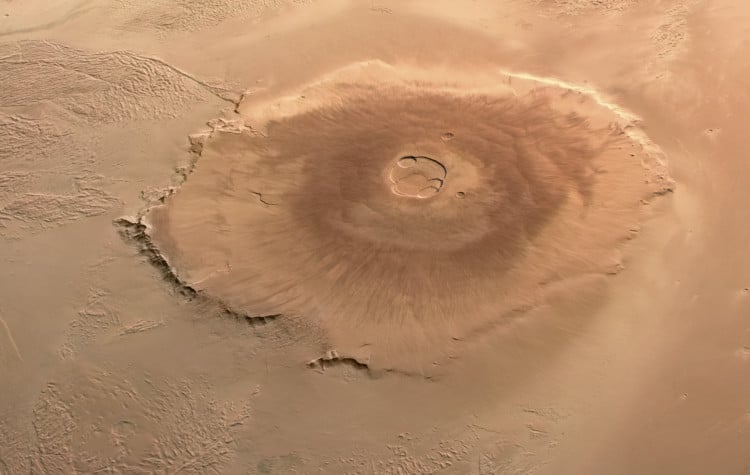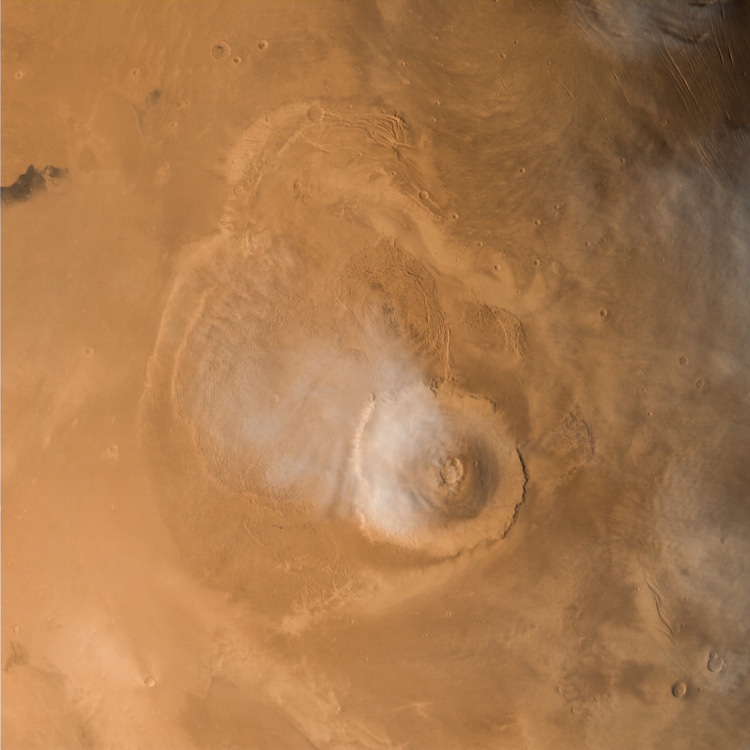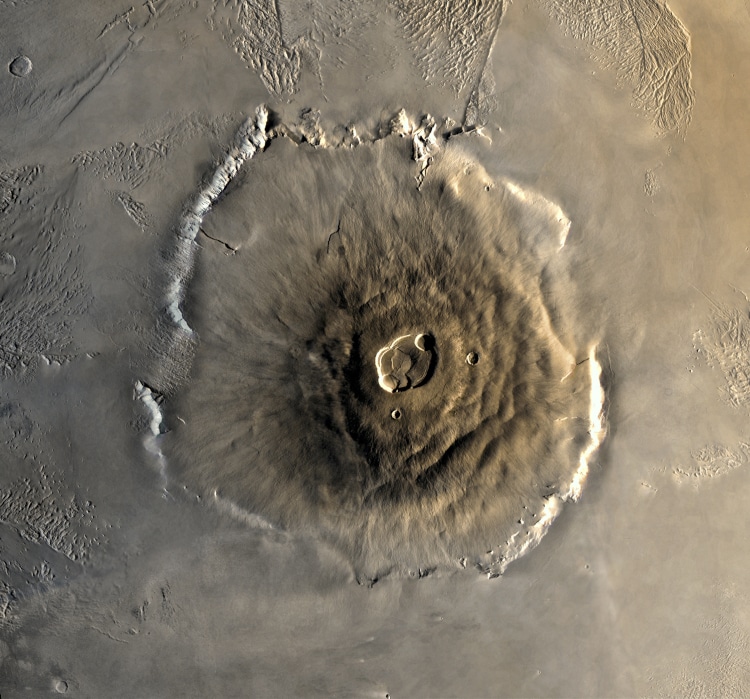
Photo: ESA/DLR/FUBerlin/AndreaLuck via Wikimedia Commons (CC BY-SA 3.0 IGO)
As impressive as the highest peaks on Earth are, they barely compare to the tallest mountains in our solar system. Namely, Olympus Mons is a giant volcano on Mars that towers 16 miles above the neighboring plains and stretches 374 miles. In fact, it is so broad, that it doesn’t look like a typical mountain found on Earth. If you were standing on it, it would simply appear like a soft slope.
To better understand how tall it is, Olympus Mons is three times as high as Mount Everest (5.5 miles) and roughly the same size of the state of Arizona and as wide as France. It is even much bigger than Hawaii’s Mauna Loa, the tallest volcano on Earth, which rises 6.3 miles above the sea floor (and 2.6 miles above sea level).
Located in the Tharsis Montes region near the Martian equator, Olympus Mons is a shield volcano. This means that rather than fiercely ejecting molten material, it was created by lava slowly flowing down its sides. Due to this, the mountain has an almost flat appearance, with an average slope of only 2º to 5º. Olympus Mons’ shape is the result of many thousands of highly fluid, basaltic lava flows.
At its summit, there is a 53-mile diameter crater, or caldera, comprising several mutually intersecting craters. Its size has long been attributed to the stability of the Martian crust and to a long accumulation time, possibly having taken billions of years to form. However, some regions of the mountain may be only a few million years old. This indicates a chance that it’s still an active volcano that could erupt at some point. Scientists think it could have stayed volcanically active for hundreds of millions of years, meaning it’s been active far longer than any volcano on Earth.
Olympus Mons’ sweeping features are also a testament to the differences between Mars and Earth. On our planet, plate tectonics spread magma out, which keeps terrestrial volcanoes from growing taller over time. Meanwhile, Mars is too small for plate tectonics. This, alongside a lower surface gravity, allowed for the lava on Mars to pile up higher.
Geological evidence found in towering cliffs that ring Olympus Mons have sparked questions about its past. In 2023, a team led by Anthony Hildenbrand of Université Paris-Saclay published a study that revealed Olympus Mons displays similarities with volcanic islands on Earth, such as the Azores and the Canary Islands, suggesting that it could have been a volcanic island once.
While Olympus Mons remains a mystery even to NASA itself, scientists have been able to get increasingly striking images of this mammoth volcano, capturing its intricacies and teaching us key details about the Martian landscape.
Olympus Mons is a giant volcano on Mars that towers 16 miles above the neighboring plains.

Photo: Kevin M. Gill via Wikimedia Commons (CC BY 2.0)
To better understand how tall it is, Olympus Mons is three times as high as Mount Everest (5.5 miles) and roughly the same size of the state of Arizona and as wide as France.

Photo: Image by NASA, modifications by Seddon via Wikimedia Commons (Public domain)
Located in the Tharsis Montes region near the Martian equator, Olympus Mons is a shield volcano.

Photo: Resident Mario via Wikimedia Commons (CC BY-SA 3.0)
The volcano was created by lava slowly flowing down its sides. Due to this, the mountain has an almost flat appearance, with an average slope of only 2º to 5º.
Olympus Mons(Mars)- The tallest mountain in the Solar System pic.twitter.com/q3eZkjQNev
— Curiosity (@MAstronomers) December 9, 2023
h/t: [Space]
Related Articles:
Giant Volcano the Size of Mount Everest Is Discovered on Mars
Explore the Surface of Mars in 4K Resolution With Footage Captured by NASA’s Rovers
Scientists Discover Water Ice Deposits on Mars That Are More Than 2 Miles Thick
Curiosity Rover Has Been Climbing a Mountain on Mars Since 2014
